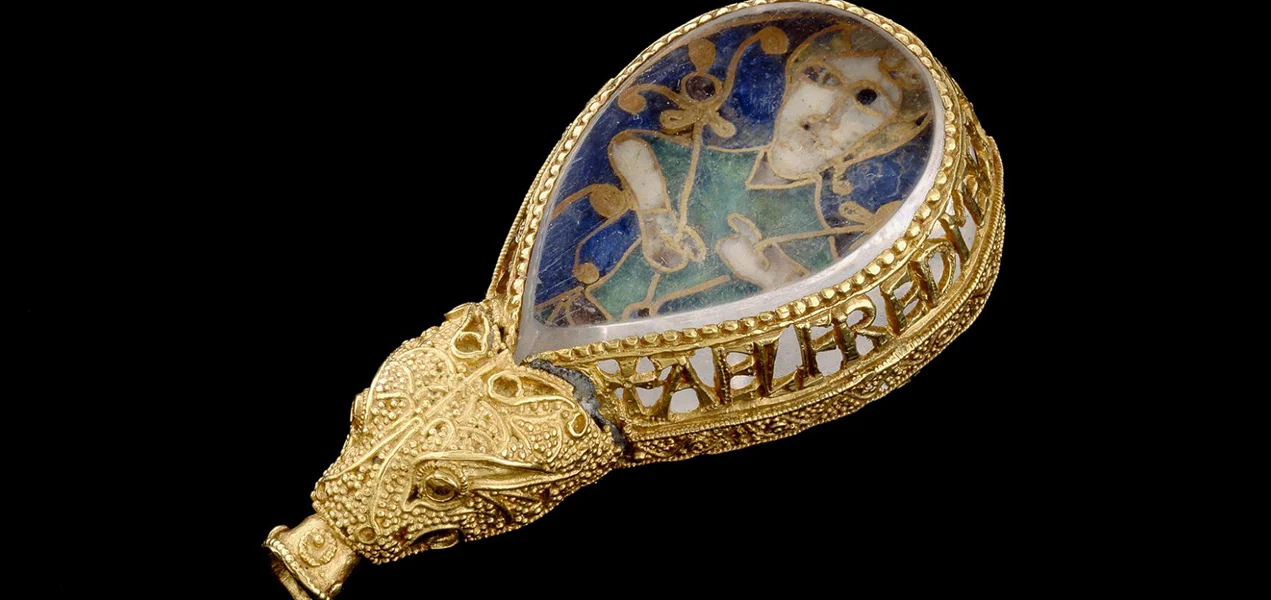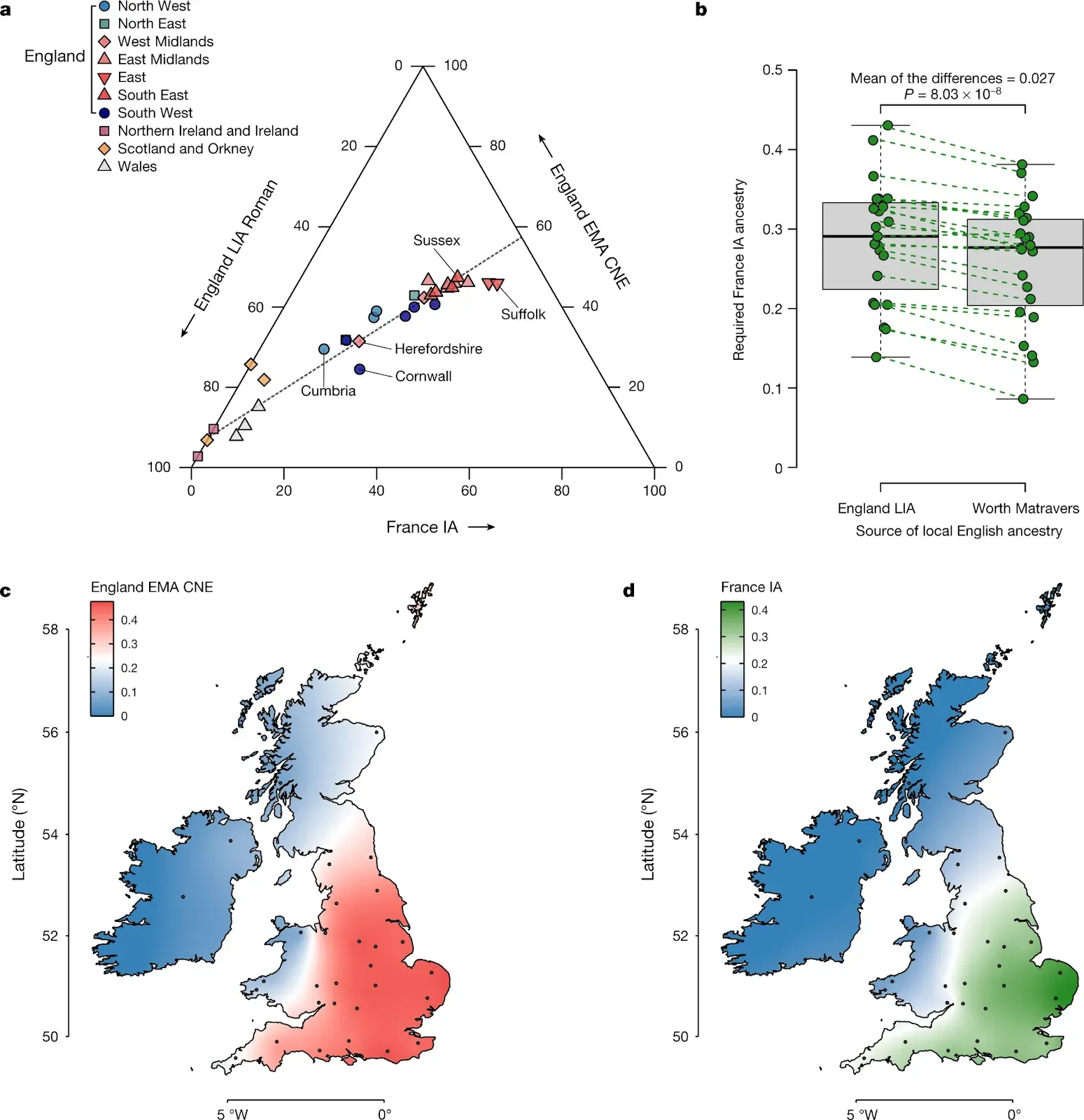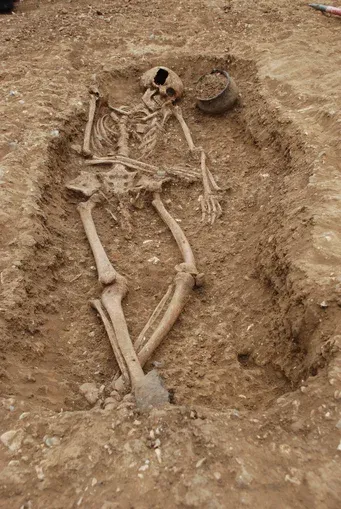
Believed to have been commissioned by King Alfred the Great and inscribed "AELFRED MEC HEHT GEWYRCAN" (Alfred me had made) in the West Saxon dialect.
The answer might surprise those little Englander nationalists who took us out of the European Union, as well as those on the far right who foster daft notions of English racial purity, because even in the Early Middle Ages, the average English person was actually only about 40% Anglo-Saxon, and even that proportion of the 'English' genome came from continental regions bordering the North Sea, including the Netherlands, Germany and Denmark. 20%-40% came from what is today Belgium and France. The rest is derived mostly from the indigenous population that was present at the time of the Roman occupation - Brythonic Welsh. The evidence is that the Germanic immigrants sometimes integrated and intermarried in some area, while in other places they formed which might have been an elite upper class.

That fact is confirmed by the work done by the Max Planck Institute and University of Central Lancashire, scientists.
Hwæt. We Gardena in geardagum, þeodcyninga, þrym gefrunon, hu ða æþelingas ellen fremedon. Oft Scyld Scefing sceaþena þreatum, monegum mægþum, meodosetla ofteah, egsode eorlas. Syððan ærest wearð feasceaft funden, he þæs frofre gebad, weox under wolcnum, weorðmyndum þah, oðþæt him æghwylc þara ymbsittendra ofer hronrade hyran scolde, gomban gyldan. þæt wæs god cyning. ðæm eafera wæs æfter cenned, geong in geardum, þone god sende folce to frofre; fyrenðearfe ongeat þe hie ær drugon aldorlease lange hwile. Him þæs liffrea, wuldres wealdend, woroldare forgeaf; Beowulf wæs breme blæd wide sprang, Scyldes eafera Scedelandum in. Swa sceal geong guma gode gewyrcean, fromum feohgiftum on fæder bearme, þæt hine on ylde eft gewunigen wilgesiþas, þonne wig cume, leode gelæsten; lofdædum sceal in mægþa gehwære man geþeon. Him ða Scyld gewat to gescæphwile felahror feran on frean wære. Hi hyne þa ætbæron to brimes faroðe, swæse gesiþas, swa he selfa bæd, þenden wordum weold wine Scyldinga; leof landfruma lange ahte.
Pronunciation:
þ - 'th' as in 'thing';
ð - 'th' as in other;
æ - 'a' as 'a' in 'bat'
LO, praise of the prowess of people-kings of spear-armed Danes, in days long sped, we have heard, and what honor the athelings won! Oft Scyld the Scefing from squadroned foes, from many a tribe, the mead-bench tore, awing the earls. Since erst he lay friendless, a foundling, fate repaid him: for he waxed under welkin, in wealth he throve, till before him the folk, both far and near, who house by the whale-path, heard his mandate, gave him gifts: a good king he! To him an heir was afterward born, a son in his halls, whom heaven sent to favor the folk, feeling their woe that erst they had lacked an earl for leader so long a while; the Lord endowed him, the Wielder of Wonder, with world’s renown. Famed was this Beowulf: far flew the boast of him, son of Scyld, in the Scandian lands. So becomes it a youth to quit him well with his father’s friends, by fee and gift, that to aid him, aged, in after days, come warriors willing, should war draw nigh, liegemen loyal: by lauded deeds shall an earl have honor in every clan. Forth he fared at the fated moment, sturdy Scyld to the shelter of God. Then they bore him over to ocean’s billow, loving clansmen, as late he charged them, while wielded words the winsome Scyld, the leader beloved who long had ruled.
The term 'Anglo-Saxons' gives a clue to their origins. The English refer to themselves as 'English (Anglish)' from the European Germanic tribe, the Angles, but the Scots and Welsh refer to them as Sassenach and Sais, respectively - words derived from 'Saxon'. England itself didn't exist until 927 when King Aethelstan completed the process started by Alfred the Great in 886, unifying the various Anglo-Saxon kingdoms, Wessex (West Saxons), Mercia, Northumbria, East Anglia, Sussex (South Saxons) and Kent, mostly as a defensive alliance against the Vikings and Danes and it was this relatively young English nation that the Norman French conquered under Duke William of Normandy in 1066, defeating the last Anglo-Saxon king, Harold Godwinson at Hastings. But who exactly were these Anglo-Saxon people who moved into Britain following the collapse of the Western Roman Empire and the abandonment of the British garrison? This is the question that a group of researchers from the Max Planck Institute for Evolutionary Anthropology, Leipzig, Germany and the University of Central Lancashire, UK set out to answer by their analysis of over 400 individuals from ancient Britain, Ireland, Germany, Denmark and the Netherlands. The results show the detail of one of the largest population movements in the post-Roman world.
The Max Planck Institute News release explains:
Around three hundred years after the Romans left, scholars like Bede wrote about the Angles and the Saxons and their migrations to the British Isles. Scholars of many disciplines, including archaeology, history, linguists and genetics, have debated what his words might have described, and what the scale, the nature and the impact of human migration were at that time.The team's open access paper in Nature contains the following charts:
New genetic results now show that around 75 percent of the population in Eastern and Southern England was made up of migrant families whose ancestors must have originated from continental regions bordering the North Sea, including the Netherlands, Germany and Denmark. What is more, these families interbred with the existing population of Britain, but importantly this integration varied from region to region and community to community.With 278 ancient genomes from England and hundreds more from Europe, we now gained really fascinating insights into population-scale and individual histories during post-Roman times. Not only do we now have an idea of the scale of migration, but also how it played out in communities and families.
Joscha Gretzinger, co lead author
Max Planck Institute for Evolutionary Anthropology
Leipzig, Germany
Using published genetic data from more than 4,000 ancient and 10,000 present-day Europeans, Gretzinger and colleagues identified subtle genetic differences between the closely related groups inhabiting the ancient North Sea region.
Migrants intermixed with the local population
Upon arrival, the migrants intermixed with the local population. In one case, in an Anglo-Saxon cemetery from Buckland near Dover, researchers were able to reconstruct a family tree across at least four generations and identify the point in time when migrants and locals intermarried. This family showed a large degree of interaction between the two gene pools. Overall, the researchers witnessed burials of prominent status across the studied cemeteries of both local and migrant origin.An early Anglo-Saxon grave with pottery vessel, brooches and a Roman Spoon. This grave 66 from Oakington Cambridgeshire contained a woman of mixed ancestry.© Duncan Sayer
The interdisciplinary team consisting of over 70 authors was able to integrate archaeological data with these new genetic results, which revealed that women of immigrant origin were buried with artifacts more often than women of local origin, especially considering items such as brooches and beads. Interestingly, men with weapons were found to have both genetic origins equally often. These differences were locally mediated with prominent burials or wealthy graves seen across the range of origins. For example, a woman buried with a complete cow in Cambridgeshire was genetically mixed, with majority local ancestry.We see considerable variation in how this migration affected communities. In some places, we see clear signs of active integration between locals and immigrants, as in the case of Buckland near Dover, or Oakington in Cambridgeshire. Yet in other cases, like Apple Down in West Sussex, we see that people with immigrant and local ancestry were buried separately in the cemetery. Perhaps this is evidence of some degree of social separation at this site.
Duncan Sayer, co-lead author
University of Central Lancashire
Preston, Lancashire, UK
Family tree reconstruction featuring integration of local ancestry into an immigrant kin group. The genetic pedigree of 13 related individuals at Dover Buckland. Indicated are the mtDNA haplogroups, Y-chromosome haplogroups, and associated grave goods of each individual. Males are depicted as squares, females as circles.
© Nature (CC-BY)Impact of this historic migration on present-day English peopleIt remains unclear whether this additional ancestry related to Iron Age France is connected to a few punctuated migration events, such as the Norman conquest, or whether it was the result of centuries-long mobility across the English Channel. Future work, specifically targeting the medieval period and later will reveal the nature of this additional genetic signal.
Stephan Schiffels, lead senior author
Max Planck Institute for Evolutionary Anthropology
Leipzig, Germany.
With the new data, the team could also consider the impact of this historic migration today. Notably the present-day English derive only 40 percent of their DNA from these historic continental ancestors, whereas 20 to 40 percent of their genetic profile likely came from France or Belgium. This genetic component can be seen in the archaeological individuals and in the graves with Frankish objects found in early Medieval graves, particularly in Kent.

Shown are (1) continental sites that are genetically indistinguishable from the more than 95% CNE EMA English (England EMA CNE) population using qpWave and provide fitting P values as source in a two-way qpAdm model of England EMA, as well as (2) the predicted locations for 72 England EMA CNE genomes using LOCATOR52. The red dashed line marks where 95% of the qpAdm and qpWave data are located.

a, Ternary plot of present-day British–Irish populations as a three-way admixture between late Iron Age and Roman England (England LIA Roman) (n = 32), France IA (n = 26) and England EMA CNE (n = 109). b, Boxplot comparison of France IA ancestry proportions in 23 English PoBI sampling regions using either England LIA Roman (n = 32) or Worth Matravers (n = 16) as source for local British ancestry in qpAdm. The P value obtained from a two-sided paired Student’s t-test is shown. The bounds of the box represent the 25th and 75th percentile, the centre represents the median, and the whiskers represent the minimum and maximum values in the data. Dashed lines connect points from the same region. c, Geographical distribution of the England EMA CNE, ancestries based on the interpolation of 31 present-day population estimates. The coordinates of the sample collection districts approximate the centroids of the averaged birthplaces of the grandparents. d, Same as c, but for France IA.
AbstractThe English then are a mixture of various European peoples speaking a language derived from early dialects of the Germanic languages spoken by the Iron Age people who moved into the political vacuum in north-western Europe and Britain left by the collapse of the Western Roman Empire, and the indigenous Celtic people, with a hefty later injection of Old French, possibly brought in by the Norman. About as racially pure as an Indian street mongrel is a pedigree dog.
The history of the British Isles and Ireland is characterized by multiple periods of major cultural change, including the influential transformation after the end of Roman rule, which precipitated shifts in language, settlement patterns and material culture1. The extent to which migration from continental Europe mediated these transitions is a matter of long-standing debate2,3,4. Here we study genome-wide ancient DNA from 460 medieval northwestern Europeans—including 278 individuals from England—alongside archaeological data, to infer contemporary population dynamics. We identify a substantial increase of continental northern European ancestry in early medieval England, which is closely related to the early medieval and present-day inhabitants of Germany and Denmark, implying large-scale substantial migration across the North Sea into Britain during the Early Middle Ages. As a result, the individuals who we analysed from eastern England derived up to 76% of their ancestry from the continental North Sea zone, albeit with substantial regional variation and heterogeneity within sites. We show that women with immigrant ancestry were more often furnished with grave goods than women with local ancestry, whereas men with weapons were as likely not to be of immigrant ancestry. A comparison with present-day Britain indicates that subsequent demographic events reduced the fraction of continental northern European ancestry while introducing further ancestry components into the English gene pool, including substantial southwestern European ancestry most closely related to that seen in Iron Age France5,6.
Gretzinger, Joscha; Sayer, Duncan; Justeau, Pierre, et al.
The Anglo-Saxon migration and the formation of the early English gene pool
Nature 2022 DOI: 10.1038/s41586-022-05247-2
Copyright: © 2022 The authors. Published by Springer Nature Ltd. Open access
Reprinted under a Creative Commons Attribution 4.0 International license (CC BY 4.0)




No comments :
Post a Comment
Obscene, threatening or obnoxious messages, preaching, abuse and spam will be removed, as will anything by known Internet trolls and stalkers, by known sock-puppet accounts and anything not connected with the post,
A claim made without evidence can be dismissed without evidence. Remember: your opinion is not an established fact unless corroborated.